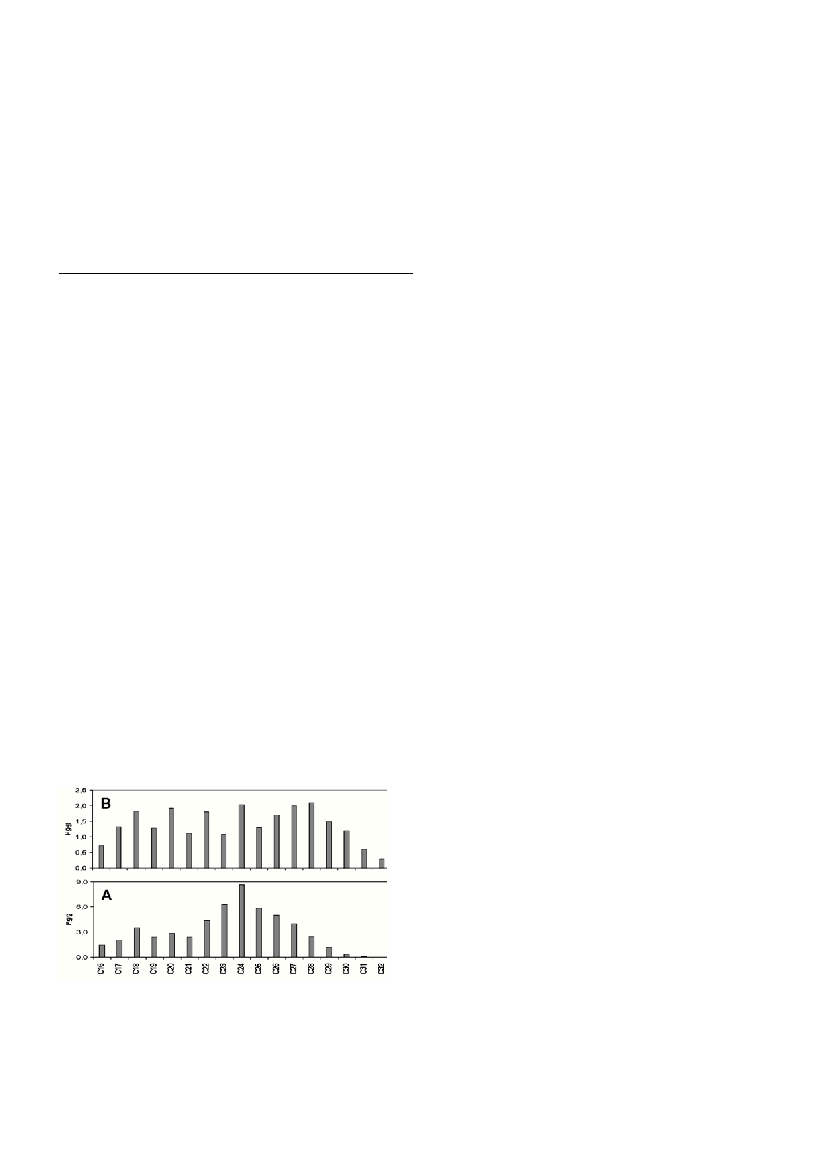Rapp. Comm. int. Mer Médit., 36,2001
103
n-
h
exane (alkanes), (II) 5 ml of 1:2 n-
h
ex
a
n
e
-
d
i
c
h
l
o
r
o
m
e
t
h
a
n
e
(PAHs), (III) 5 ml of 1:1 dichloromethane-methanol (alcohols and
sterols), and (IV) 5 ml of methanol. The different fractions were rotary
evaporated to almost dryness, reconstituted with iso-octane, and
s
p
i
ked with 1-phenyldodecane, octachloronaphthalene and epi-
choprostanol as internal standards, respectively, for alkanes, PAHs and
sterols. The determination of the individual components of the differ-
ent fractions was performed by capillary gas chromatography (30 m x
0.25 mm i.d. DB-5 fused silica) coupled to a Fisons MD800 mass
spectrometer, under the conditions described elsewhere (3).
Results and Discussion
Particle ?uxes were highly variable and clearly different at the two
sites. During most of the sampling period, one or two orders of mag-
nitude more particulates were produced and exported at vent site A
than at control station B. Mean ?uxes throughout the summer period
at sites A and B were 2207 and 251 mg m
-2
d
-1
, respectively (2).
Although the traps were deployed within a total distance of 3.5 nau-
tical miles, the settling particles differed between sites not only in
quantity but also in their composition. Effectively, the difference in
mean ?uxes between sites was even more significant for POC than for
total mass ?uxes, with averages of 549 and 30 mg POC m
-2
d
-1
at sites
A and B, respectively, indicating a higher contribution of abiogenic
material in the latter. However, the particles collected at all sites dur-
ing the observation period were largely related to pelagic production,
and were mainly composed of zooplankton detritus. The sinking par-
ticles collected in summer at station A were mostly amorphous marine
snow with very few fecal pellets. Bacteria were also more abundant in
samples from the vent site A than in those at the site further away.
Apparently, the higher ?uxes in the vent site were a consequence of an
enhanced production and export of organic material originating from
the thermophilic ecosystem developed around the vents.
The profiles of aliphatic and aromatic hydrocarbons exhibited strik-
ing differences between particles of the two sites, A and B. The com-
position of sinking particles in station A, in?uenced by the thermal
vent, exhibited an aliphatic fraction with a clear petrogenic fingerprint
(Figure 2), whereas station B showed n-alkane distributions with a
high even carbon number predominance in the C16-C24 range, which
could be attributed to a biogenic (planktonic) origin (4).
On the other hand, the aromatic fraction in particles from station A
exhibited a high predominance of alkylated PAHs, whereas a more
pyrogenic nature was observed in station B. The profiles in station B
were consistent with atmospheric deposition of remote continental
aerosols. In turn, the enhanced biological production in station A may
have significantly contributed to the sedimentation of the more
bioavailable petrogenic hydrocarbons accumulated by organisms and
subsequently exported within fast sinking fecal pellets.
The sterol composition in the sinking particles also differed both in
concentration and composition according to the sampling area. In fact,
particles collected in the thermal vent affected area (A) exhibited
remarkably unusual concentrations of 5
ß
-stanols and related stanones,
which were not detected or occurred at very low concentrations in the
other area. The higher concentrations of sterols at station A is consis-
tent with a higher productivity mostly associated to blooms of diatoms
(
?
5
,
?
5,22
and
?
5,24(28)
stenols) in clear contrast with the oligotrophic
conditions prevailing at the reference station B.
In summary, the Aegean Sea hydrothermal system has a strong but
rather limited in?uence on the production of particulate organic mat-
ter and the transport of petrogenic compounds in the water column.
Acknowledgements
The present work was supported by the EC MAST III Program
under contract No. MAS3-CT95-0021. The IAEA Marine
Environment Laboratory operates under an agreement between the
IAEA and the Government of the Principality of Monaco.
References
1.- Dando, P.R., et al., 2000. Hydrothermal studies in the Aegean Sea.
Phys. Chem. Earth(B), 25, 1-8.
2.- Miquel, J.C., Fowler, S.W., La Rosa, J., Aliani, S. and Meloni, R.,
1998. Particulate and organic ?uxes in a coastal hydrothermal area off
Milos, Aegean Sea. Rapp. Comm. Int. Mer Medit., 35, 276-277.
3.- Dachs J., Bayona, J.M., Ittekkot, V. and Albaigés, J. 1999. Monsoon-
driven vertical ?uxes of organic pollutants in the Western Arabian Sea.
Environ. Sci. Technol., 33, 3949-3956
4.- Elias, V.O., Simoneit, B.R.T. and Cardoso, J.N., 1997. Even n-alkane
predominance on the Amazon Shelf and a Northeast Pacific hydrothermal
system.Naturwiss.,84, 415-420.
GEOCHEMICAL CHARACTERIZATION OF PARTICULATE ORGANIC MATTER ASSOCIATED WITH
HYDROTHERMAL VENT ACTIVITY IN THE COASTAL AEGEAN SEA.
J. M. Bayona
1
,A. Monjonell
1
, J.C. Miquel
2
, S.W. Fowler
2
and J. Albaigés
1
*
1
Department of Environmental Chemistry (CID-CSIC), Barcelona, Spain -*albqam@cid.csic.es
2
IAEA – Marine Environment Laboratory, Monaco
Abstract
Two particle interceptor traps were moored from June to September 1996 along the SE coast of Milos (Aegean Sea), in an area known for
its extensive seabed geothermal activity.The settling particles collected differed between sites not only in quantity but also in their
composition. In the area directly in?uenced by the warm water vents, the vertical ?ux of particulate material was almost one order of
magnitude higher than that observed in the reference site, and its lipid composition (sterols) re?ected a locally enhanced productivity,
mostly associated to diatom blooms, which play a significant role in the accumulation and deposition of petrogenic hydrocarbons from the
water column.
Key-words: Aegean Sea, thermal vents, particulates, chemical analysis
Fig. 2. n-Alkane distributions in particulates from stations A
and B.

